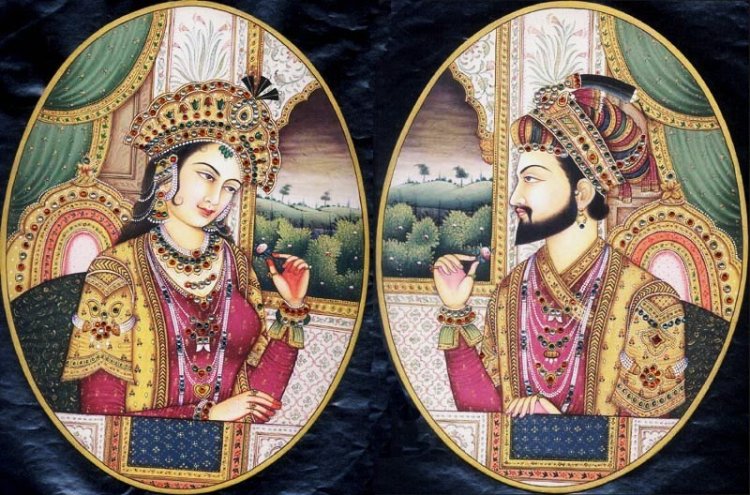शाहजहां ने कैसे और किस तरह से बनवाया ताज महल ?
इससे बनने में आखिर कितना समय लगा ?

शाहजहां ने कैसे और किस तरह से बनवाया था मुमताज के लिए ताजमहल ?

ताजमहल उत्तर प्रदेश के आगरा जिले में लगभग 17 हेक्टेयर में फैले विशाल मुगल उद्यान में यमुना नदी के दाहिने किनारे पर स्थित है।
ताजमहल को भारत-इस्लामी वास्तुकला की पूरी श्रृंखला में सबसे बड़ी स्थापत्य उपलब्धि माना जाता है। इसकी मान्यता प्राप्त स्थापत्य सुंदरता में ठोस और रिक्त स्थान, अवतल और उत्तल और प्रकाश छाया का लयबद्ध संयोजन है; जैसे मेहराब और गुंबद सौंदर्य पहलू को और बढ़ाते हैं। हरे-भरे स्केप रेडिश पाथवे और उसके ऊपर नीला आकाश का रंग संयोजन स्मारक को हमेशा बदलते रंग और मनोदशा में दर्शाता है। संगमरमर में राहत कार्य और कीमती और अर्ध-कीमती पत्थरों से जड़ाई इसे एक स्मारक से अलग बनाती है।
ताजमहल की विशिष्टता शाहजहाँ के बागवानी योजनाकारों और वास्तुकारों द्वारा किए गए कुछ उल्लेखनीय नवाचारों में निहित है। ऐसी ही एक प्रतिभाशाली योजना है, सटीक केंद्र के बजाय चतुर्भुज उद्यान के एक छोर पर मकबरा रखना, जिसने स्मारक के दूर के दृश्य में समृद्ध गहराई और परिप्रेक्ष्य जोड़ा। यह भी उठे हुए मकबरे की किस्म के सर्वोत्तम उदाहरणों में से एक है।
मकबरे को एक वर्गाकार मंच पर और मीनारों के अष्टकोणीय आधार के चारों ओर कोनों पर वर्ग से आगे बढ़ाया गया है। मंच के शीर्ष पर दक्षिणी ओर के केंद्र में प्रदान की गई सीढ़ियों की पार्श्व उड़ान के माध्यम से पहुंचा जाता है। ताजमहल की जमीनी योजना संरचना के सही संतुलन में है, केंद्र में अष्टकोणीय मकबरा कक्ष, पोर्टल हॉल और चार कोने वाले कमरे से घिरा हुआ है। योजना ऊपरी मंजिल पर दोहराई जाती है। मकबरे का बाहरी भाग चौकोर है, जिसमें चम्फर्ड कोने हैं।
बड़ा दो मंजिला गुंबददार कक्ष, जिसमें मुमताज महल और शाहजहाँ की कब्रें हैं, योजना में एक आदर्श अष्टकोण है। दोनों कब्रों को घेरने वाली उत्कृष्ट अष्टकोणीय संगमरमर की जालीदार स्क्रीन शानदार कारीगरी का एक नमूना है। यह अत्यधिक पॉलिश किया गया है और बड़े पैमाने पर जड़ाई के काम से सजाया गया है। फ्रेम की सीमाओं को कीमती पत्थरों से जड़ा गया है जो अद्भुत पूर्णता के साथ निष्पादित फूलों का प्रतिनिधित्व करते हैं। पत्तियों और फूलों को बनाने के लिए इस्तेमाल किए गए पत्थरों के रंग और रंग लगभग असली लगते हैं।
मुमताज़ महल का सेनोटाफ मकबरे के कक्ष के एकदम केंद्र में है, जिसे एक आयताकार मंच पर रखा गया है, जिसे जड़े हुए फूलों के पौधे के रूपांकनों से सजाया गया है। शाहजहाँ की कब्र मुमताज महल से भी बड़ी है और तीस साल से भी अधिक समय बाद इसके पश्चिम में बाद के किनारे पर स्थापित की गई है। ऊपरी कब्रें केवल भ्रामक हैं और असली कब्रें निचले मकबरे के कक्ष (क्रिप्ट) में हैं, जो शाही मुगल कब्रों में अपनाई गई प्रथा है।
मंच के कोनों पर चार मुक्त खड़ी मीनारों ने मुगल वास्तुकला में एक अज्ञात आयाम जोड़ा। चार मीनारें न केवल स्मारक का एक प्रकार का स्थानिक संदर्भ प्रदान करती हैं बल्कि भवन को त्रि-आयामी प्रभाव भी प्रदान करती हैं।
मकबरे के बगल में ताजमहल परिसर में सबसे प्रभावशाली, मुख्य द्वार है जो प्रांगण की दक्षिणी दीवार के केंद्र में भव्य रूप से खड़ा है। द्वार उत्तर मोर्चे पर डबल आर्केड दीर्घाओं से घिरा हुआ है। दीर्घाओं के सामने के बगीचे को दो मुख्य पैदल मार्गों द्वारा चार क्वार्टरों में विभाजित किया गया है और प्रत्येक क्वार्टर को संकरे क्रॉस-एक्सियल वॉकवे द्वारा उप-विभाजित किया गया है, जो बगीचे में दीवारों की तिमुरीद-फ़ारसी योजना पर है। पूर्व और पश्चिम में बाड़े की दीवारों के बीच में एक मंडप है।
ताजमहल एक आदर्श सममित योजनाबद्ध इमारत है, जिसमें केंद्रीय अक्ष के साथ द्विपक्षीय समरूपता पर जोर दिया गया है, जिस पर मुख्य विशेषताएं रखी गई हैं। उपयोग की जाने वाली निर्माण सामग्री ईंट-इन-लाइम मोर्टार है जो लाल बलुआ पत्थर और संगमरमर से ढकी हुई है और कीमती / अर्ध कीमती पत्थरों का जड़ना काम है।
ताजमहल परिसर में मस्जिद और गेस्ट हाउस केंद्र में संगमरमर के मकबरे के विपरीत लाल बलुआ पत्थर से बने हैं। दोनों भवनों के सामने छत पर एक बड़ा मंच है। मस्जिद और गेस्ट हाउस दोनों एक जैसे ढांचे हैं। उनके पास एक आयताकार विशाल प्रार्थना कक्ष है जिसमें केंद्रीय प्रभावशाली पोर्टल के साथ एक पंक्ति में व्यवस्थित तीन गुंबददार खण्ड हैं। पोर्टल मेहराब और स्पैन्ड्रेल के फ्रेम को सफेद संगमरमर से सजाया गया है। स्पैन्ड्रेल पत्थर के इंटर्सिया के फूलदार अरबी से भरे हुए हैं और मेहराब रस्सी मोल्डिंग से घिरे हुए हैं।
इससे बनने में आखिर कितना समय लगा ?
इसका निर्माण मुगल सम्राट शाहजहाँ ने अपनी पत्नी मुमताज महल की याद में 1632 ईस्वी में इस का काम शुरू हुआ था और 1648 ईस्वी में इससे पूरा किया गया था, जिसमें मस्जिद, गेस्ट हाउस और दक्षिण में मुख्य प्रवेश द्वार, बाहरी प्रांगण और इसके मठ जोड़े गए थे।बाद में 1653 ई. में पूरा हुआ।
बाद में यह 1653 ई. में पूरा हुआ। अरबी लिपि में कई ऐतिहासिक और कुरानिक शिलालेखों के अस्तित्व ने ताजमहल के कालक्रम को स्थापित करने में मदद की है। इसके निर्माण के लिए, पूरे साम्राज्य से और मध्य एशिया और ईरान से भी राजमिस्त्री, पत्थर काटने वाले, इनलेयर, नक्काशी करने वाले, चित्रकार, सुलेखक, गुंबद बनाने वाले और अन्य कारीगरों की मांग की गई थी। ताजमहल के मुख्य वास्तुकार उस्ताद-अहमद लाहौरी थे।
How and how did Shah Jahan build the Taj Mahal for Mumtaz?
The Taj Mahal is situated on the right bank of the Yamuna River in the sprawling Mughal Gardens spread over 17 hectares in the Agra district of Uttar Pradesh.
The Taj Mahal is considered the greatest architectural achievement in the entire range of Indo-Islamic architecture. Its recognized architectural beauty is the rhythmic combination of solids and spaces, concave and convex and light shadows; Like arches and domes further enhance the aesthetic aspect. The color combination of the lush green scape-reddish pathway and the blue sky above depicts the monument in an ever-changing color and mood. The relief work in marble and inlay in precious and semi-precious stones make it a monument apart.
The uniqueness of the Taj Mahal lies in some of the remarkable innovations made by the horticultural planners and architects of Shah Jahan. One such genius plan is to place the mausoleum at one end of the quadrilateral garden rather than the exact centre, which added rich depth and perspective to the distant view of the monument. It is also one of the best examples of the raised tomb type.
The tomb is extended beyond the square on a square platform and at the corners around the octagonal base of the minarets. The top of the platform is reached via a lateral flight of stairs provided in the center of the southern side. The ground plan of the Taj Mahal is in perfect balance of the structure, with the octagonal tomb chamber in the centre, surrounded by the portal hall and four corner rooms. The plan is repeated on the upper floor. The exterior of the tomb is square, with chamfered corners.
The large two-storey domed chamber, which houses the tombs of Mumtaz Mahal and Shah Jahan, is a perfect octagon in plan. The exquisite octagonal marble lattice screen enclosing both the tombs is a specimen of splendid workmanship. It is highly polished and richly decorated with inlay work. The borders of the frame are studded with precious stones which represent the flowers executed with amazing perfection. The colors and hues of the stones used to make the leaves and flowers look almost surreal.
The Cenotaph of Mumtaz Mahal is at the very center of the tomb chamber, which is placed on a rectangular platform, decorated with inlaid flowering plant motifs. Shah Jahan's tomb is larger than that of Mumtaz Mahal and was established more than thirty years later on the latter's west side. The upper tombs are only deceptive and the original tombs are in the lower tomb chamber (crypt), a practice followed in the royal Mughal tombs.
Four free-standing minarets at the corners of the platform added an unknown dimension to Mughal architecture. The four minarets not only provide a kind of spatial context to the monument but also give the building a three-dimensional effect.
The most impressive in the Taj Mahal complex, next to the mausoleum, is the main gate which stands majestically in the center of the southern wall of the courtyard. The gate is surrounded by double arcaded galleries on the north front. The garden in front of the galleries is divided into four quarters by two main walkways and each quarter is subdivided by narrow cross-axial walkways, which take on the Timurid-Persian plan of the walls in the garden. There is a mandapa in the middle of the enclosure walls on the east and west.
The Taj Mahal is an ideally symmetrical planned building, with an emphasis on bilateral symmetry with a central axis on which the main features are placed. The building material used is brick-in-lime mortar covered with red sandstone and marble and inlay work of precious/semi-precious stones.
The mosque and guest house in the Taj Mahal complex are made of red sandstone in contrast to the marble mausoleum in the centre. There is a big platform on the roof in front of both the buildings. Both the mosque and the guest house are similar structures. They have a rectangular huge prayer hall with three domed bays arranged in a row with a central impressive portal. The portal arch and the frame of the spandrel are decorated with white marble. Spandrels are filled with flowery arabesques of stone intarsia and the arches are surrounded by rope molding.
How long did it take to make this?
Its construction was started by the Mughal Emperor Shah Jahan in memory of his wife Mumtaz Mahal in 1632 AD and was completed in 1648 AD, adding the mosque, guest house and the main entrance to the south, the outer courtyard and its monasteries. Later completed in 1653 AD.
Later it was completed in 1653 AD. The existence of several historical and Quranic inscriptions in Arabic script has helped establish the chronology of the Taj Mahal. For its construction, masons, stonecutters, inlayers, carvers, painters, calligraphers, dome makers and other craftsmen were sought from all over the empire and also from Central Asia and Iran. The chief architect of the Taj Mahal was Ustad-Ahmed Lahori.

































